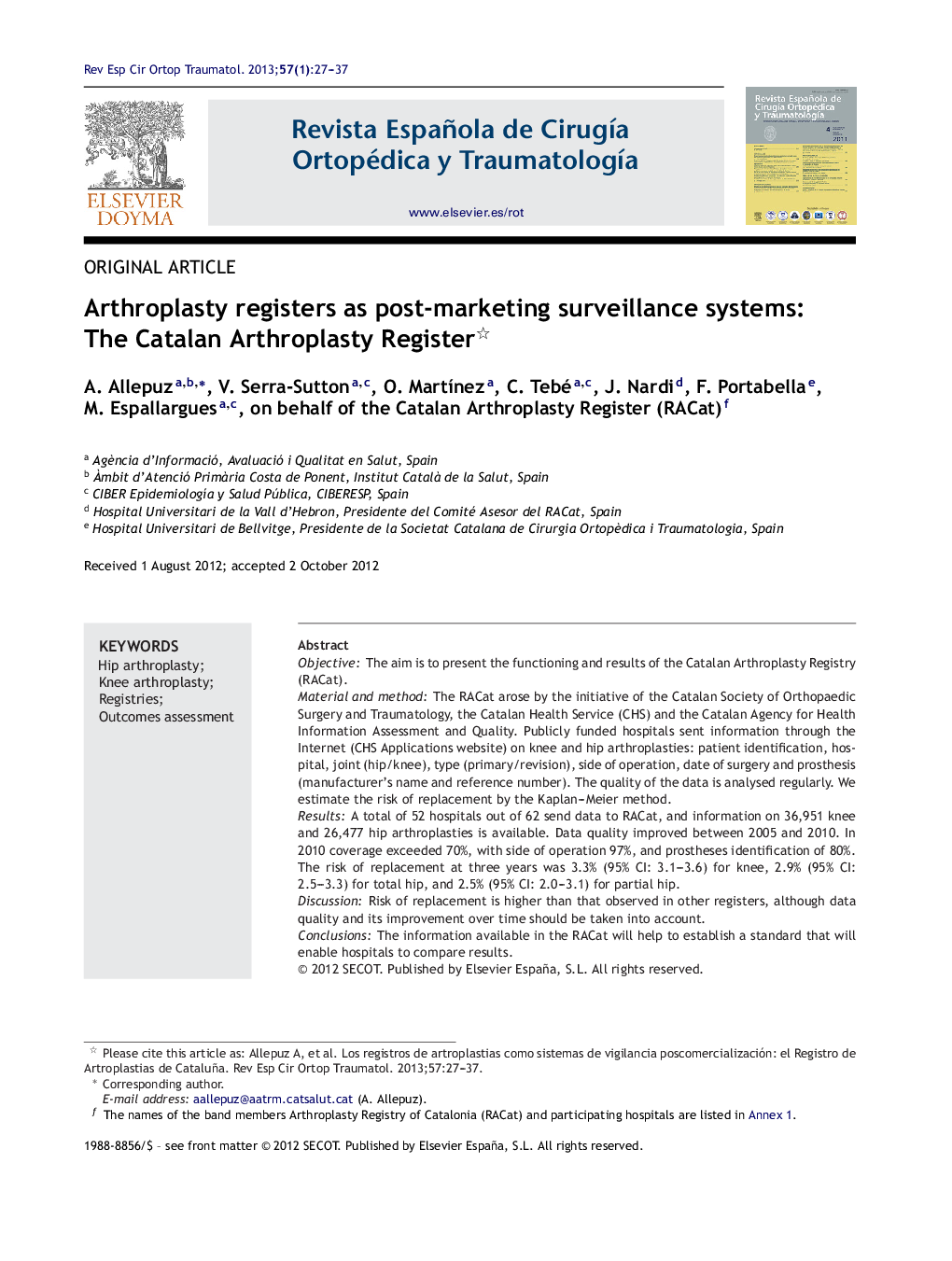| کد مقاله | کد نشریه | سال انتشار | مقاله انگلیسی | نسخه تمام متن |
|---|---|---|---|---|
| 4087245 | 1268025 | 2013 | 11 صفحه PDF | دانلود رایگان |

ObjectiveThe aim is to present the functioning and results of the Catalan Arthroplasty Registry (RACat).Material and methodThe RACat arose by the initiative of the Catalan Society of Orthopaedic Surgery and Traumatology, the Catalan Health Service (CHS) and the Catalan Agency for Health Information Assessment and Quality. Publicly funded hospitals sent information through the Internet (CHS Applications website) on knee and hip arthroplasties: patient identification, hospital, joint (hip/knee), type (primary/revision), side of operation, date of surgery and prosthesis (manufacturer's name and reference number). The quality of the data is analysed regularly. We estimate the risk of replacement by the Kaplan–Meier method.ResultsA total of 52 hospitals out of 62 send data to RACat, and information on 36,951 knee and 26,477 hip arthroplasties is available. Data quality improved between 2005 and 2010. In 2010 coverage exceeded 70%, with side of operation 97%, and prostheses identification of 80%. The risk of replacement at three years was 3.3% (95% CI: 3.1–3.6) for knee, 2.9% (95% CI: 2.5–3.3) for total hip, and 2.5% (95% CI: 2.0–3.1) for partial hip.DiscussionRisk of replacement is higher than that observed in other registers, although data quality and its improvement over time should be taken into account.ConclusionsThe information available in the RACat will help to establish a standard that will enable hospitals to compare results.
ResumenObjetivoEl objetivo de este trabajo es presentar el funcionamiento y los resultados del Registro de Artroplastias de Cataluña (RACat).Material y métodoEl RACat surgió por iniciativa de la Sociedad Catalana de Cirugía Ortopédica y Traumatología, el Servicio Catalán de la Salud (SCS) y la Agencia de Información, Evaluación y Calidad en Salud. Los hospitales financiados públicamente envían mediante Internet (portal de aplicaciones, SCS) información sobre las artroplastias de rodilla y cadera: identificación del paciente, hospital, articulación (cadera/rodilla), tipo (primaria/recambio), lateralidad, fecha de cirugía y prótesis (fabricante y número de referencia). La calidad de los datos se analiza periódicamente. El riesgo de recambio se estima mediante el método de Kaplan-Meier.ResultadosEn total 52 hospitales de 62 envían datos al RACat que dispone de información sobre 36.951 artroplastias de rodilla y 26.477 de cadera. La calidad de los datos mejoró entre 2005 y 2010, superando la cobertura el 70%, la información sobre lateralidad el 97% y la identificación de prótesis el 80%. El riesgo de recambio a los 3 años fue del 3,3% (IC 95%: 3,1-3,6) para rodilla, del 2,9% (IC 95%: 2,5-3,3) para las totales de cadera, y del 2,5% (IC 95%: 2,0-3,1) para las parciales.DiscusiónEl riesgo de recambio es superior al observado en otros registros, aunque es necesario tener en cuenta la calidad de la información disponible y su mejora en el tiempo.ConclusionesLa información disponible en el RACat permitirá establecer un estándar de referencia que permita a los hospitales evaluar sus resultados.
Journal: Revista Española de Cirugía Ortopédica y Traumatología (English Edition) - Volume 57, Issue 1, January–February 2013, Pages 27–37